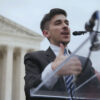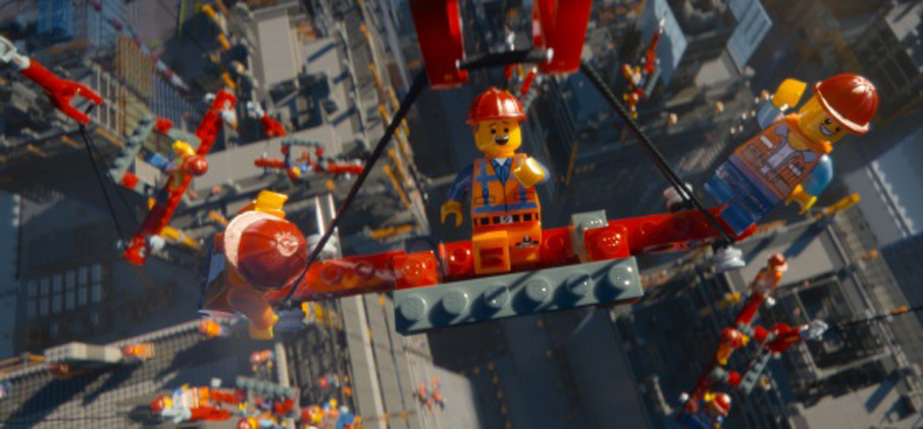When Dan Lin, a producer of “The Lego Movie” was putting together a sizzle reel five years ago to convince the studio that a film based on the building bricks might be as enjoyable as playing with them, his first call wasn’t to an animator, a writer or a director. Instead, he called the composer Mark Mothersbaugh, who as usual knew just the right note to strike.
“I just happened to mention that I’d just finished a film with Phil [Lord] and Chris [Miller] and he should check it out,” recalls Mothersbaugh. “I basically got them their job and the movie wouldn’t have happened if it wasn’t for me — I doubt that’s true, but I’m thinking about starting that as the new legend.”
Whether or not Mothersbaugh was instrumental in the hiring of Lord and Miller, the “21 Jump Street” writer/directors who share the musician’s subversive streak, there’s no doubt that his instruments laid the groundwork for the film. A singular pop culture confection that continues a tradition of introducing generation after generation to unique sounds ever since he first took the stage as the frontman for Devo, “The Lego Movie” would seem to offer a showcase for Mothersbaugh’s entire career, sonically adventurous throughout as the score weaves together the mischievous electronica he’s best known for with the more traditional orchestral work he’s been doing as a film composer on such films as “Rushmore” and television shows as “Enlightened” as it runs through all the settings the Danish company has created from the wild west to the high seas.
Employing 35 synthesizers, a 40-person choir and even the legendary whistler Alessandro Alessandroni of “Once Upon a Time in the West” fame at one point, Mothersbaugh makes Legoland his own, something he’s done with numerous artforms throughout his eclectic career and shortly after the release of “The Lego Movie,” he took time to reflect on creating soundscapes from scratch, the infectious “Everything is Awesome” and a few of his favorite current film composers.
Since it seems like a perfect mix of sensibilities, how did you and Phil Lord and Chris Miller initially meet?
They say we met when they were working as storyboard artists at “Rugrats'”and got fired 15 or 16 years ago. As working partners, we met for ‘Cloudy With a Chance of Meatballs 1’ because fortunately for me, they didn’t have a long list of composers they were interested in meeting. I made the short list and we hit it off.
Is animation a different beast than live action?
Oh yeah, totally. You have much more heavy lifting to do in animation than you do in live action because in the best animation you don’t see things happening. There are bugs in the ground that you can’t see, but they’re moving around, there’s wind blowing that even the best, most sophisticated animation hasn’t matched yet. Animation needs the help of humans, the feel of humans with music. That’s why you almost always hear an orchestra in an animated film. There’s nothing better than 80 or 100 humans all bowing a string and blowing into a horn because even if you don’t see them, you feel it. You feel it in a way you don’t feel with samples and you don’t feel it with synthesizers or just one or two people. Sonically, that many players bring life to the movie. On the other hand, you have other chores. In “Rugrats,” you have to create an orchestral sound of a diaper wrinkling while a kid stumbles across a floor. You have all sorts of interesting things that you are responsible for.
Since “Everything is Awesome” is weaved throughout the film, was that song a starting point for the entire score?
I saw them as [having] totally different purposes. The score has a whole bunch of other jobs to do than the song. The song is pretty clever. It starts off like this irritating commercial, a 30-second long thing that just drives people on and gets the people of Legoland to make sure they show up at work on time. By the end of the movie, the same lyrics kind of take on this twist of a meaning where it becomes about people working together and cooperating to do something bigger than they could do by themselves. I’ve got to say those guys really did have a good idea with that song. How did they get that smart? I don’t know. I’m glad that people are responding to it.
In the scene that’s set in a Western milieu, you can hear the song being whistled by none other than Alessandro Alesandroni, who is famous for lending his lips to Sergio Leone. Why was it important to have him?
We were talking about how to make the Western section — all the different parts of Legoland have their individual sounds and we were talking about how to make the Legoland sound unique and I suggested why don’t we see if we can get Alessandro? I had met him once. I went to dinner at somebody’s house and he whistled a medley of all of his Ennio Morricone things. It was amazing. We called him up and he was up to the task. We recorded it in Italy and we dropped it into the film over here.
Was it difficult to balance the more traditional orchestral elements of the score with the electronic-based elements?
It’s becoming more and more common now to have hybrid scores. People don’t feel like they have enough instruments in an orchestra to get all the sounds that they need for the film, so it’s really common for there to be a big electronic package and a full orchestra. For this film, I had one interesting thing I had to do because the directors had already started on “22 Jump Street” and weren’t around when I was recording with the orchestra. Just to be safe, I over-recorded, so I have almost the whole movie [scored with] this electronic ‘Legoland’ rave-y stuff, then I also have a score of the movie that’s almost 100% traditional orchestral music.
I did that so they could dial back and forth while they were [working on the other film and] for their individual mixes depending on what emotional moment they wanted to create when they were doing their final mix for the film. I wanted to give them the ability to dial towards a more of an electronic sound and get it more edgy and aggressive or dial it more towards a traditional orchestra and go for more emotion and pathos. This one was a little more work than normal.
As a pioneer of electronica, is it interesting to see it so embraced now that it can be part of a family film such as this?
Of course. Film music is much more sophisticated than it was 30 or 40 years ago. At one time, everything was like a 30 to 60 piece orchestra and that was it. Now, it’s such a wide open playing field with all sorts of electronics. People are using different, very conceptually interesting styles. I like to listen to other composers because there’s a lot of composers out there that inspire me. Mychael Danna goes around the world and records authentic Indian or Asian or African musicians, wherever they are and they bring a lot to his movies. I loved his score for “Life of Pi.” Thomas Newman is one of my all-time favorite film composers. I even liked [Teddy Shapiro’s] “Walter Mitty” score, [which] I thought was really interesting. I hear scores all the time where people do things that I’m just really amazed by.
Because you work in so many different mediums besides music, do you find they inform one another?
For me, it’s all the same thing. I don’t differentiate that way. I just try to pick the best medium to solve an aesthetic problem. I feel as equally comfortable painting or shooting a camera or playing a guitar or singing or playing piano. They all come from the same place.
“The Lego Movie” is now in theaters.




